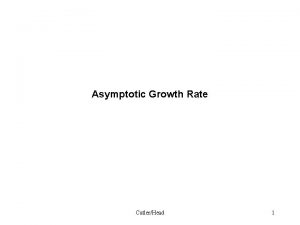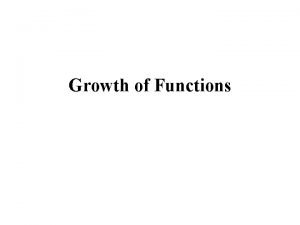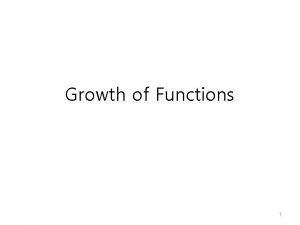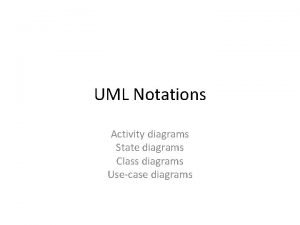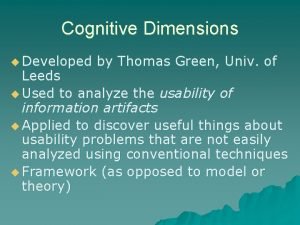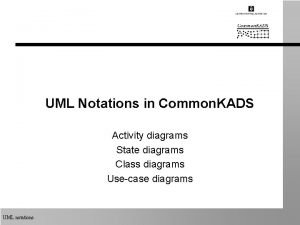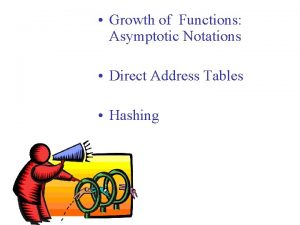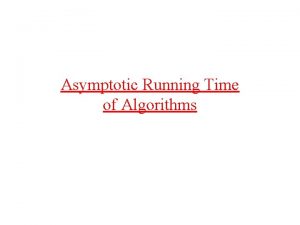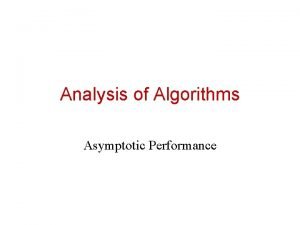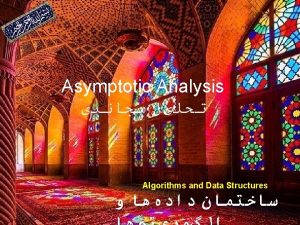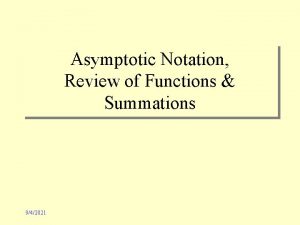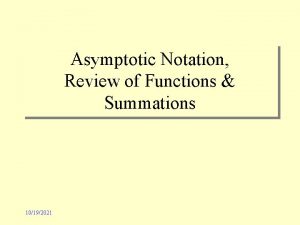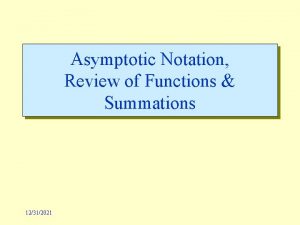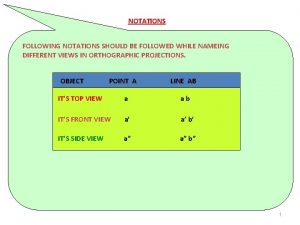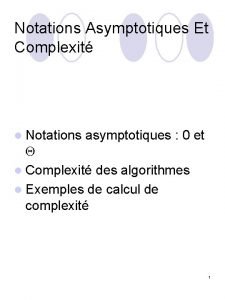Asymptotic Notations Algorithms Lecture 9 Growth of functions












- Slides: 12

Asymptotic Notations Algorithms Lecture 9

Growth of functions • The order of growth of the running time of an algorithm, gives a simple characterization of the algorithm’s efficiency and also allow us to compare the relative performance of alternative algorithms. • Once the input size n becomes large enough , Merge sort ( in the worst case ) with its ( n log n ) out performs Insertion sort in the worst case whose running time is (n 2 ). • We are studying the asymptotic efficiency of algorithms. That is , we are concerned with how the running time of an algorithm increases with the size of the input in the limit, as the size of the input increased without bound. • So, we give a bound to the running time when the input increased without bound. 2 Algorithms Lecture 9 Dr. Arwa Zabian

Asymptotic Notations • The notation we use to describe the asymptotic running time of an algorithm are defined in terms of functions. Whose domain are the set of natural numbers N={0, 1, 2, 3…}. • So, using the asymptotic notation we describe the running time T(n) of an algorithm for an integer input size 3 Algorithms Lecture 9 Dr. Arwa Zabian

Notation • Definition : for a given function g(n) , we denote (g(n)) the set of functions (g(n)) = { f(n): there exists a positive constant c 1 , c 2 and n 0 , such that : 0 c 1 g(n) f(n) c 2 g(n) for all n n 0 } That means we must choose a value n 0 from which the definition of is hold If the definition of is hold for n n 0. means give upper bound and lower bound. That means give an equal bound. 4 Algorithms Lecture 9 Dr. Arwa Zabian

Notation • In other words , for all n n 0, the function f(n) is equal to g(n) to within a constant factor. • We say that g(n) is an asymptotically tight bound for f(n) • The definition of (g(n)), requires that every number of (g(n)) be asymptotically non negative. • That is, that f(n) be non negative whenever n is sufficient large. • Consequently, the function g(n) it self must be asymptotic non negative, or else the set (g(n)) is empty 5 Algorithms Lecture 9 Dr. Arwa Zabian

Exercise • Use the formal description to show that g(n) = ½ n 2 - 3 n = (n 2 ) solution : To do so, we must determine positive constant c 1 , c 2 and n 0 such that: c 1 n 2 ½ n 2 – 3 n c 2 n 2 for all n n 0 dividing by n 2 yields: 6 Algorithms Lecture 9 c 1 ½ - 3/n c 2 For 7 > n 1 G(n) always negative so, we choose n 0 = 1/14 and c 1 = 1/14 , c 2 =1/2 That means for all n 0 7 we can find two constant that makes the inequality correct. That means g(n)= (n 2 ) Dr. Arwa Zabian

Exercise • Using the formal definition proof that 6 n 3 ≠ (n 2 ) We assume that 6 n 3 = (n 2 ) So given the definition for all n n 0 C 1 n 2 6 n 3 c 2 n 2 c 1 6 n c 2 /6 Which cannot possibly hold for arbitrary large n , since c 2 is constant 7 Algorithms Lecture 9 Dr. Arwa Zabian

O -notation • O notation gives an asymptotic upper bound • Definition : for a given function g(n) , we denote O (g(n)) the set of functions O(g(n)) = { f(n): there exists a positive constant c, and n 0 , such that : 0 f(n) c g(n) for all n n 0 } • For all value n to the right of n 0 , the value of the function f(n) is on or below g(n). • O notation gives an upper bound on a function • Using O-notation , we can often describe the running time of an algorithm merely by inspection the algorithm’s over all structure. 8 Algorithms Lecture 9 Dr. Arwa Zabian

Exercise • The algorithm is composed on two loops. The inner loop while for j 2 to length[A] is executed one time its cost O(1) that consists on assignment do key A[j] to the key and comparisons. insert A[j] into the sorted • The indices i, j are executed n sequence A[1…. j-1] times i j-1 • So immediately we say that the running time is O(n 2) in the While i> 0 and A[i] < key worst case. Insertion sort 1. 2. 3. 4. 5. 6. do A[i+1] 7. i i-1 8. A[i+1] 9 A[i] key Algorithms Lecture 9 Dr. Arwa Zabian

O -notation • When we said the running time is O (n 2) in the worst case means : 1. the algorithm cannot run worst than n 2 2. This value is for every input • however, (n 2) in the worst case does not imply a bound on the running time for every input ( but specific input ) That means O is more general than So, we are interested in studying the behavior of the algorithm when the input is increased. 10 Algorithms Lecture 9 Dr. Arwa Zabian

notation • notation provides an asymptotic lower bound • Definition : for a given function g(n) , we denote (g(n)) the set of functions (g(n)) = { f(n): there exists a positive constant c, and n 0 , such that : 0 c g(n) f(n) for all n n 0 } • For all value n to the right of n 0 , the value of the function f(n) is on or above g(n). 11 Algorithms Lecture 9 Dr. Arwa Zabian

Theorem • For any two functions f(n) and g(n), f(n) = (g(n)) if and only if : f(n) = O(g(n)) and f(n) = (g(n)) That means has the same asymptotic bound if and only if is upper and lower bounded by g 12 Algorithms Lecture 9 Dr. Arwa Zabian
 Asymptotic growth rate
Asymptotic growth rate Asymptotic runtime
Asymptotic runtime Standard notations and common functions
Standard notations and common functions Analysis of algorithms lecture notes
Analysis of algorithms lecture notes Introduction to algorithms lecture notes
Introduction to algorithms lecture notes Uml activity diagram notation
Uml activity diagram notation Ssd diagram
Ssd diagram In engineering notation, what is multiples of three?
In engineering notation, what is multiples of three? Deployment diagram notations
Deployment diagram notations Cognitive dimensions of notations
Cognitive dimensions of notations Uml
Uml Running record error rate
Running record error rate Prefix polish notation
Prefix polish notation
